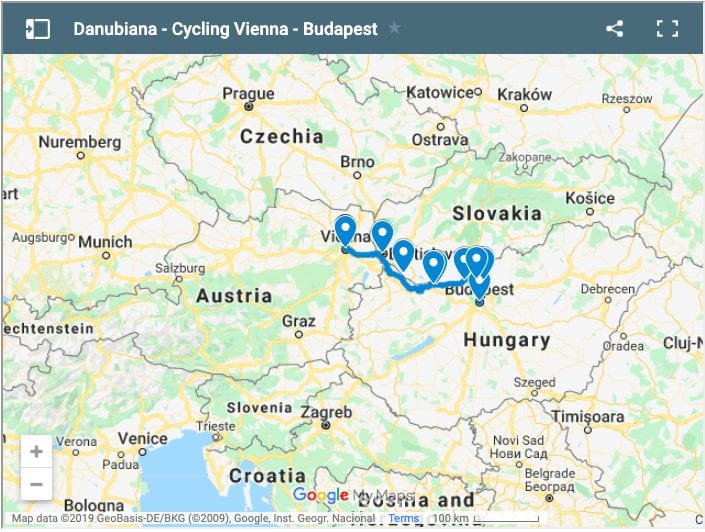Last Updated on 22 August 2024 by Cycloscope
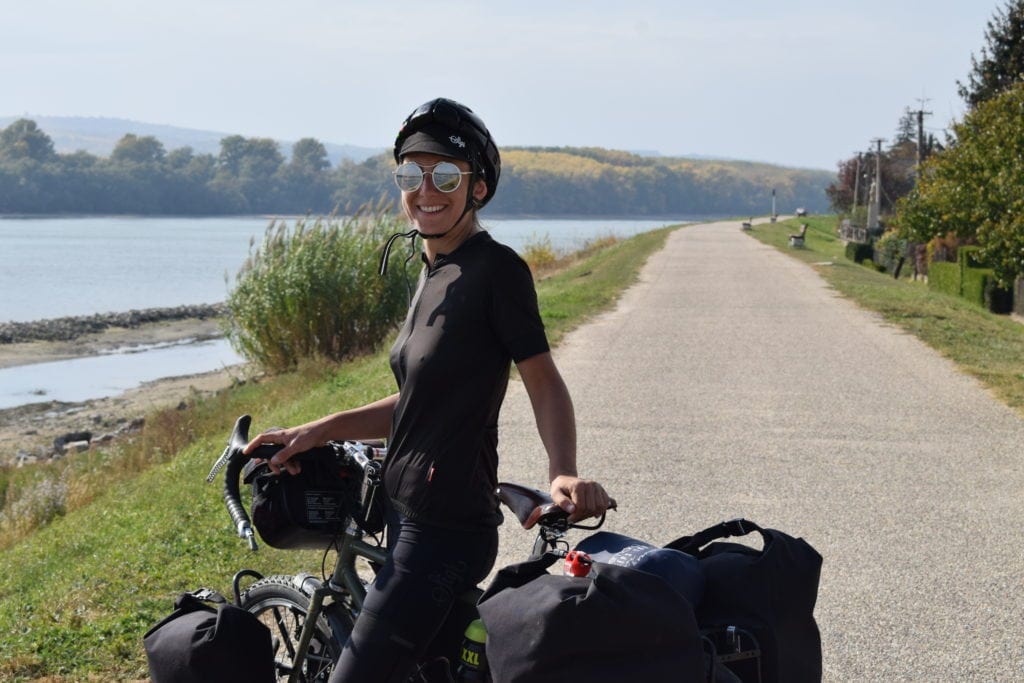
Cycling the Danube from Budapest to Vienna
maps, routes, advice everything you need to know to organize your Danubiana bike tour
The cycle path along the Danube is probably the most famous route in Europe, and certainly the longest; from Germany to Austria, then cutting out national borders between Slovakia and Hungary, Croatia and Serbia, Serbia and Romania, and then to the shores of the Black Sea, for a total of 1400 kilometers.
This section is part of the Euro-zone 6 that connects the Black Sea to the Atlantic Ocean, in France for a total length of 4400 kilometers. A few years ago we cycled a part of the Danube cycling path between Serbia and Romania, among the marvelous Iron Gates, while we recently traveled the EV6 (EuroVelo 6) from Vàc, in Hungary to Vienna, in Austria, passing through Bratislava.
We cycled in this last one in October so we did not meet almost any other cyclist down the road, except for a Korean guy who cycled with us to Vienna and helped us not to die of boredom in some parts of the way.
Yes, the idea of cycling along the Danube may seem romantic but often the landscape remains the same for miles and miles. In our opinion, the most boring part is from Bratislava to Vienna, for long stretches the river cannot be seen and there are constant detours for works.
We must admit that we liked much more the stretch traveled between Serbia and Romania we rode years ago. In any case, the Euro Velo 6 cycle route is almost always on a dedicated cycle path, along the way there are restaurants, hotels, and campsites, it is very suitable for family cycling holidays and, in general, for all types of bicycle travelers, trained or not.
In this article, we will talk about the last part of Danubiana we have traveled, from Vàc to Vienna.
Below you can see the track of the route, keep in mind that in some places you can also ride the cycleway on the other side of the river. We were coming from Slovakia into Hungary so we hit the bike path around Vac, but you can also start in Budapest if you are interested in visiting the city.
Learn More about Cycling in Slovakia
Have a look at the best bike routes in Poland!
Alpe Adria Cycle Trail – The Alps for Everyone
Danube River Cycling Path – Map and GPX track
Maps and Apps: how to navigate the Danube by bike
There is an official app with offline maps and tracks, you can find it here, it costs a couple of euros and in addition to the Danube map, you can download for free the GPX tracks of all EuroVelo routes.
If you prefer the old style you can also resort to paper maps, we only found this on Amazon though they should be available in major city libraries. It must be said that routing is not really essential in some sections of the cycle path, for example in Austria and Germany, where signs are always present.
The only “catch” is the crossing of the river, in summer there should be no problems but in October, when we cycled, some connections between the two banks of the Danube were no longer active.
For some countries, however, the signage is almost absent and the offline maps might be very useful. Moreover, in each country, the cycle route takes different names and acronyms:
- in Germany, the Danube cycle path is called DR6
- in Upper Austria, Obaöstarreich, it is called R1
- in Lower Austria, Niedaöstareich, is reported as R6
- in Hungary, Slovakia, and Serbia you will find EuroVelo 6 or EV6
- in the westernmost part of Serbia, but especially in Bulgaria and Romania there are no signs, often it is not a rural cycle path but secondary roads or country roads, so you have to rely on a route map.
Geography of the Danube
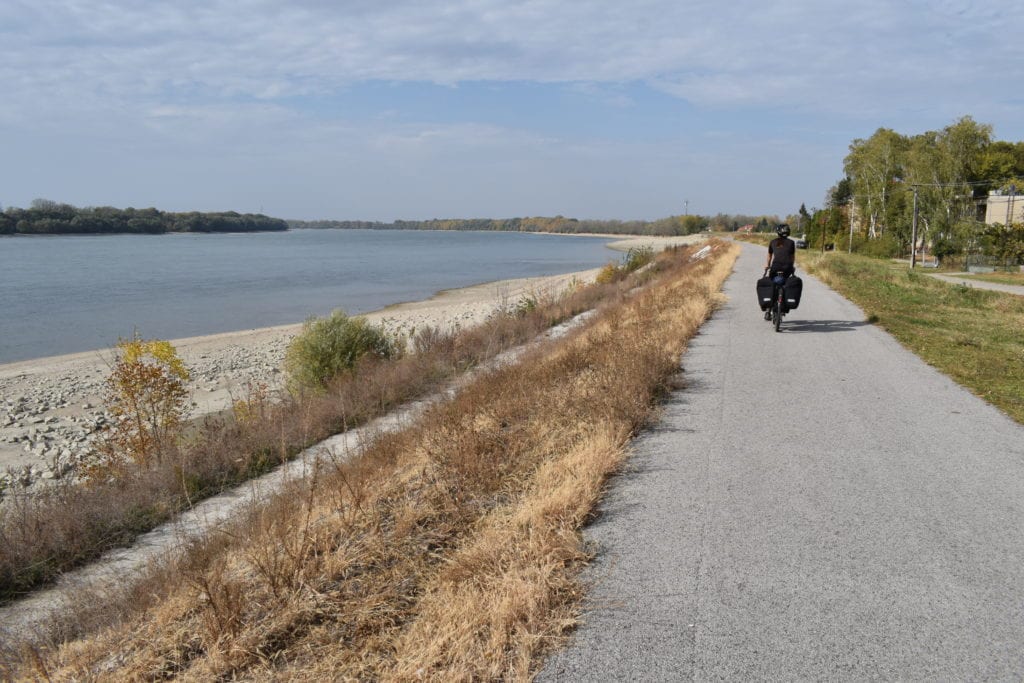
The Danube rises in the Black Forest, from the meeting of two streams, the Breg and the Brigach. Those meet in the park of an ancient castle, where a fountain symbolizes the birth of the river.
Hence the Danube course runs in Germany, Austria, Slovakia, Bratislava, Hungary, Croatia, Serbia, Romania, and Bulgaria. Near the Ukrainian border plunges into the Black Sea, here the wonderful mouth of the Danube has been recognized World Heritage Site by UNESCO.
The Danube has been one of the most important connections for goods and people for centuries. Near the mouth, where the river widens considerably, is also traveled by ocean-going ships. In the 1990s, thanks to the construction of a canal connecting the Rhine, in Germany, it became possible to sail the river from the Black Sea to the Netherlands, on the North Sea.
The climate along the Danube cycle route
Crossing so many countries, so different from each other, it’s difficult to talk about the general climate situation along the Danube.
In general, especially in its central and eastern parts, it is dominated by the continental climate while in the western part, in Germany, the area is more influenced by the Atlantic climate.
The southwestern part, which once passed through the former Yugoslavia, gets a Mediterranean climate. The Alps to the west, the Dinaric-Balkan mountain ranges to the south and the Carpathian mountain bow in the eastern center are distinctive morphological and climatic regions and barriers.
These mountain ranges receive the highest annual rainfall (1,000-3,200 mm per year) while the internal and external basins (Vienna basin, Pannonian basin, Romanian plain, and Prut), the lowlands of Czech Moravia ,and the delta region are very dry (350-600 mm per year).
From 50 to 70 days of annual snowfalls are recorded at high altitudes in the Alps and the Carpathians, while the plains have only 1-3 days/year (from http://www.undp-drp.org).
Best season to ride the Danubiana
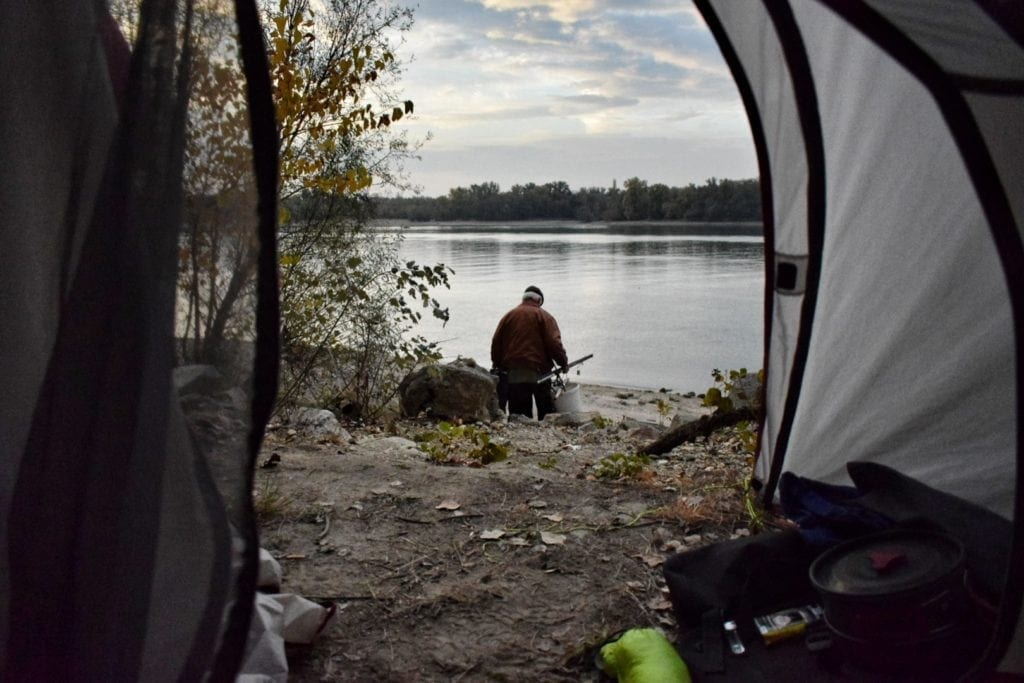
The best time to cycle along the Danube is without a doubt the summer: in June, July, and August, the longer and generally sunny days will also allow you to take a refreshing dip in the river’s waters. However, let’s say that even spring, from the end of April, is a good period as well as autumn, with its typical colors.
We cycled from Hungary to Austria in the second half of October, the days were sunny and we met very little rain but in the evening it was quite cold, say around 5 or 6 degrees, so if you plan to sleep in a tent you need to be equipped with a good sleeping bag.
Where to sleep while cycling the Danubiana
Hotels, hostels, and guest houses
We traveled this route in October and have never had any problems finding a room. Prices in Slovakia and Hungary are around 20€ X night, double that for Austria. In the busiest months, July and August, you may find full accommodations. If you are in Esztergom (Hungary) visit the Kaleidoszkóp Ház Hostel, a very charming place run by a very kind girl.
Camping
On the banks of the Danube, there are plenty of places to camp, in addition to equipped campsites you can camp freely along almost the entire route. In Slovakia free camping is allowed, there are only a couple of rules to follow:
- Camping is not allowed in level 3 protected areas (National Parks)
- Camping is not permitted in protected forest areas
The first rule means that you are not allowed to camp in the High Tatras, fortunately, there is a network of free huts particularly useful for hikers (it is not so easy to reach on a bike, I fear), some can be found here. Bonfires are forbidden but tolerated in safe areas, be very careful though. Learn more about cycling and camping in Slovakia.
In Hungary, however, wild camping is officially forbidden, even though this rule doesn’t seem to be strictly enforced. In Austria, however, free camping is prohibited so if you don’t want to risk being hunted in the middle of the night follow the general rules
- mount the tent when it is almost dark in a place not visible and dismantle it at dawn
- do not light fires
- leave no traces.
Alternatively, you can ask the locals if you can put the tent in their garden or go to an official campsite, bear in mind though… those are only open in Summer! You can use an app such as Komoot to find campsites along the way.
Hospitality
Besides asking for hospitality in the people’s garden you can use WarmShowers o Couchsurfing to find a roof and above all a shower. In the summer months, it could be a bit more difficult as those who live along the river receive dozens of requests. In Austria and Germany, you’ll find many Warmshowers hosts, less so in Slovakia and Hungary.
If you don’t know what we are talking about, have a look at our article about the best hospitality network websites.
Rent a bike along the Danube cycle route

If you are not on a long journey and you want to travel more freely without having to pack and ship the bikes, you might think of renting one on-site.
Renting a bike is more expensive than taking one’s own, taking the train with a bike is quite simple in many of the countries involved in the route so, if you plan to travel for a couple of weeks always on a bike, probably rent is not the best option.
If, however, you think of pedaling only sections and then moving by train or bus to other destinations, renting could be a convenient choice. Naturally, the services and costs change according to the country you are in, in general:
- in Germany, the cost of bike rental varies from 10 to 15€ per day and some shops provide pickup services for about 25/35€ per bike;
- in Austria, from information found on the net, prices do not seem very friendly, some services offer discounts if you are in a group, 100€ for two bikes, 120 for three bikes… to which you have to add the 15€ x pannier (if you are not provided). It is also possible to rent an electric bike, the cost is the same;
- in Hungary, on the other hand, the costs are much more reasonable: around 8/10€ a day with further discounts for a longer rental period
- in Slovakia it is possible to rent a bike for 15€, usually, the panniers are paid only once (not daily) and cost about 10€ in total;
Keep in mind that renting a bike for one day is more expensive, usually, discounts are applied for longer periods. We didn’t find particular information about bike rentals in Serbia and Romania, but we figure you can find them in the main cities. If you have information please contribute in the comments section.
What to see along the Danube cycle route
Here’s a list of interesting spots to visit along this section of the Danube, you can see their location in the map above.
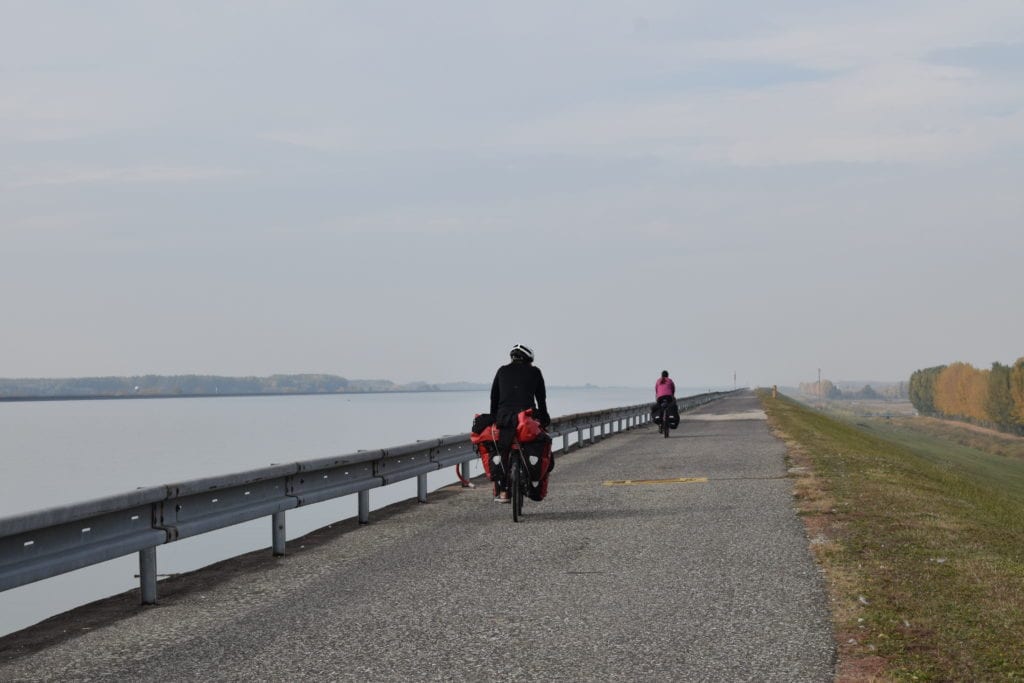
Vác (Hungary)
An ancient Hungarian city about thirty kilometers north of Budapest, it is a very lively city. Besides the numerous churches and historical monuments, it is home to interesting museums, one of them, if you are interested in the genre, is the Mummy Museum, 265 eighteenth-century Hungarian mummies and their peculiar coffins, discovered in a crypt in 1994.
Visegrad Royal Palace
This is one of the nicest spots in this section of the Danube, in our humble opinion. The Visegrád Castle towers over the scenic mountainous area.
Built by King Charles I of Hungary in the 14th century, in the late 17th century the palace complex was massively destroyed and covered with soil. It has been excavated by archaeologists only in the 1930s and then partially reconstructed. The exhibition rooms today show monuments from different eras and are open to the public.
Esztergom (Hungary)
Is the oldest city in Hungary, do not miss the cathedral, either from here or from the Slovakian side, especially in the evening, when it is lit. The 9th-century basilica is the largest in the country. Nearby is also the castle of 972 and several other churches.
In addition to the old center, there are also several restaurants overlooking the Danube. Also, the bridge that connects the city of Esztergom to Sturovo (in Slovakia), is a point not to be missed for the view it has to offer.
There are also several hotels with spas. We slept at the cheap and cool Kaleidoszkóp Ház Hostel, very welcoming with a kitchen available and internal parking for bikes.
Gyor (Hungary)
Another small, untouristy, cozy Hungarian town worth a visit. Set at the confluence of three rivers, there are many things to do in Gyor, a little city full of history.
There are many architecturally interesting old buildings, lots of cafes and bars, cute budget hostels, and splurge SPAs for those who want a real rest day. Gyor is also a very cycling-friendly city and has many pedestrian areas where to stroll.
Iza Leanyvar Castle (Hungary)
Not much remains of this fortress. It was a Roman military camp that served to protect this river crossing. It is located right along the bike path (GPS coordinates).
Komarom (Hungary and Slovakia)
This city, which has the same name on both the Hungarian and Slovak sides, is a rather large center for stocking supplies. There’s an old part that includes a fortress built in the mid-19th century and then used as a munitions depot by the Soviets. Follow the signs for Fort Monostor, Monostori Erod in Hungarian.
Bratislava (Slovakia)
Despite being the capital of Slovakia it will take a couple of hours to visit the historical city center. A man coming out of the manhole and UFO sculpture are the classic photo spots. Spend one or two nights before hitting the next section of the Danube Cycling Path from Bratislava to Vienna.
Gabcikovo power plant
It starts at the 1,836 river kilometers and is the largest hydroelectric power plant in Slovakia, guaranteeing 11% of the country’s energy needs. From here on you will travel along the artificial reservoir for several kilometers. Towards Bratislava, the Danube becomes almost a lake and is populated by thousands of birds in the right season.
Vienna
Vienna is a wonderful city, one of the most beautiful we’ve ever seen, there are so many things to see! do not miss the Imperial Crypt, the magnificent Cathedral of St Stephan, the many traditional Viennese cafés, the Globe Museum, a huge collection unique in the world (here is a list of weird things to see in Vienna). You definitely shouldn’t miss trying Austrian food, and some amazing delicacies!
Vienna is totally a bicycle-friendly city, the bike paths are everywhere and well-designed. Spend at least a couple of days, there are plenty of Warmshowers people here – if you want to splurge, this is the right place lots of great accommodation option in Vienna.
Safety

We have cycled along the Danube in Serbia, Romania, Slovakia, Hungary, and Austria and we can say that there are no particular security problems. In general, it is enough to take normal precautions, not to show off expensive things, not to get too drunk with strangers, to camp at safe places, not too close to the road but not too isolated.
Did you find it useful? Share and follow up on social networks.


